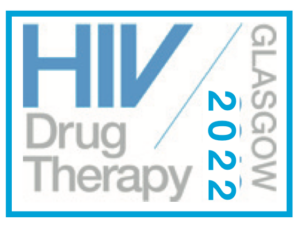Glasgow 2022: Better re-suppression after viral rebound with DTG-based ART compared to EFV- or PI-based regimens
1 December 2022. Related: Conference reports, Treatment strategies, HIV 16 Glasgow 2022.
Polly Clayden, HIV i-Base
 People receiving dolutegravir (DTG)-based HIV treatment were significantly more likely to re-suppress after initial viraemia compared to those on efavirenz (EFV)- or PI-based ART. These findings from a meta-analysis of four African trials were presented at HIV Glasgow 2022.
People receiving dolutegravir (DTG)-based HIV treatment were significantly more likely to re-suppress after initial viraemia compared to those on efavirenz (EFV)- or PI-based ART. These findings from a meta-analysis of four African trials were presented at HIV Glasgow 2022.
It compared rates of virological failure and re-suppression in four randomised trials of DTG, efavirenz (EFV) and protease inhibitors (PI/r). The trials were:
- ADVANCE, comparing DTG- to EFV-based ART, plus either tenofovir disoproxil fumarate (TDF)/emtricitabine (FTC) or tenofovir alafenamide (TAF)/FTC in treatment-naive participants in South Africa.
- NAMSAL, comparing DTG- to low dose EFV-based ART, plus TDF/lamivudine (3TC) in treatment naive participants in Cameroon.
- DolPHIN-2, comparing DTG- to EFV-based ART, plus TDF/3TC in treatment naive, pregnant women, starting ART in the third trimester, in South Africa and Uganda.
- VISEND, comparing DTG- to PI-based ART, plus tenofovir prodrugs to zidovudine (AZT) in four second-line regimens, in people who had failed NNRTI-based first-line in Zambia.
The analysis examined whether participants with virological failure during treatment with DTG should be switched or if adherence counselling led to re-suppression.
Virological failure was defined as viral load >1000 copies/mL at any visit after week 24. Re-suppression was defined as viral load <50 copies/mL at the next visit in ADVANCE, DolPHIN-2 and VISEND, or <200 copies/mL in NAMSAL.
In ADVANCE, participants had similar rates of virological failure: 11%, 13% and 8.8% in the TAF/FTC/DTG, TDF/FTC/DTG and TDF/FTC/EFV arms, respectively. But 41%, 59% and 23% of participants in the respective arms achieved re-suppression.
In NAMSAL, virological failure rates were also similar between the TDF/3TC/DTG and TDF/3TC/EFV arms: 15.7% and 17.2%. And, 60.4% and 27%, in the respective arms, re-suppressed.
In DolPHIN-2, virological failure rates were similar by treatment group: 33.1% and 30.4% in the TDF/FTC/DTG and TDF/FTC/EFV arms. But, in this study, re-suppression rates did not differ between arms: 34.1% and 34.2%, respectively.
Women in DolPHIN-2 women started ART in late stage pregnancy and experienced quite high rates of virological failure and a proportion stopped taking treatment after delivery. This is a very vulnerable population with complex psycho-social issues – which likely account for different results to the two previous studies.
Re-suppression results were significant across the three studies in ART naive participants: p<0.01, DTG vs EFV arms.
In VISEND, virological failure was less frequent in the DTG arms than the boosted PI ones: 18.75% and 12.3% vs 27.5% and 20.3% in the TDF/FTC/DTG, TAF/FTC/DTG, AZT/3TC/LPV/r and AZT/3TC/ATV/r arms respectively. Re-suppression was more frequent among participants receiving DTG: 41% and 34.6% vs 19.6% and 17.5%, in the respective arms. Re-suppression DTG vs PI, p<0.01.
Unsurprisingly, VISEND participants switching ART with <1000 copies/mL at baseline were less likely to experience virological failure.
In the meta-analysis, overall re-suppression rates were significantly higher for DTG vs EFV, p=0.04.
comment
WHO guidelines currently recommend that people with persistent viral load above 1000 copies/mL, despite adherence counselling, switch treatment.
Presenting author, Andrew Hill, asked whether or not people receiving DTG-based ART should be switched to another class and after how much adherence counselling. The research group are continuing to look at these questions and including more studies in the analyses.
He noted that the new South African ART guidelines recommend people are only switched if resistance testing shows evidence of integrase inhibitor mutations.
Although other guidelines recommend switching, poor tolerability of PIs also requires consideration.
Discussion after the presentation focused on the implications of continuing treatment in people with unsuppressed viral load. Although a substantial proportion of people receiving DTG-based ART re-suppressed, that leaves 40–50% that did not. Dr Hill explained that so far the analysis does not suggest an increased risk of integrase inhibitor mutations (although not the case with EFV).
As follow up across these studies is still relatively short (although ADVANCE has reported week 192 results), a question was raised asking if those who re-suppressed were followed for long enough, would they eventually fail, as has been observed with NNRTI-based ART.
Not raised in this discussion but quite likely to be an issue in the not-too-distant future are the population level implications of possible emerging integrase inhibitor resistance for the introduction of cabotegravir as PrEP. Cabotegravir was approved for this indication in December 2022 in South Africa and earlier this year in Zimbabwe. Pilot programmes are starting in 2023.
Reference
All abstracts are availabke in the abstract book:
https://onlinelibrary.wiley.com/doi/10.1002/jia2.26009 (abstract book)
Hill A et al. Virological failure and HIV RNA re-suppression rates in four randomised trials of dolutegravir, efavirenz or protease inhibitor-based treatment in 3116 participants. HIV Glasgow 2022. 23–26 October 2022. Oral abstract O42.
https://virtual.hivglasgow.org/programme/late-breakers-hot-topics (webcast, first presentation)
First published on 7 December 2022.

